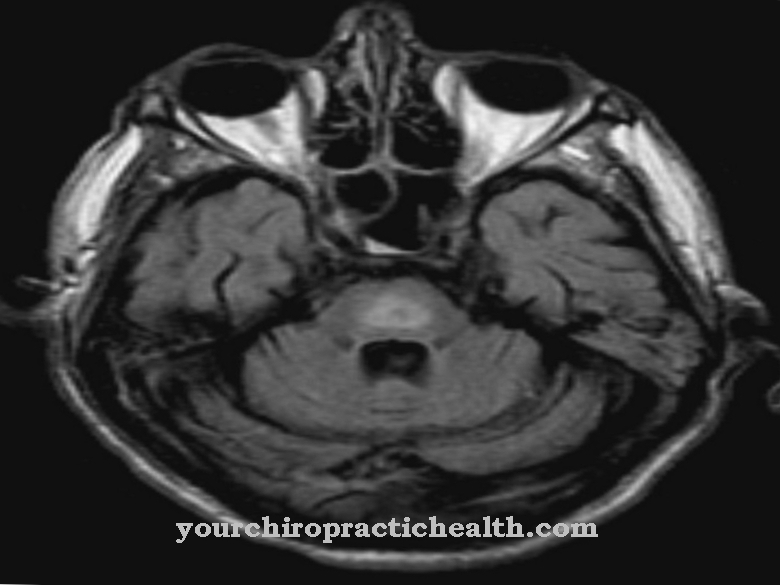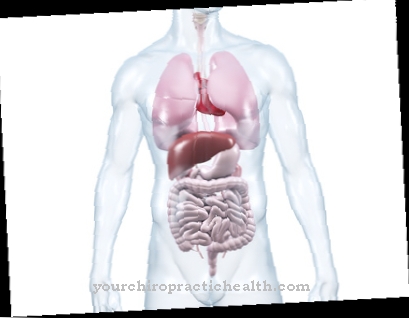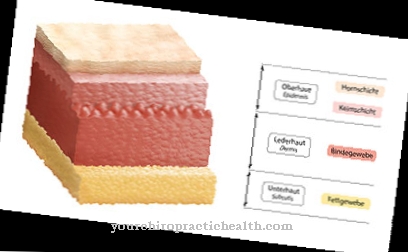The Hypophysitis is a rarely occurring inflammation of the pituitary gland. Various forms of hypophysitis are known, but not all physiological and immunological relationships have been clarified, especially not in the case of lymphocytic hypophysitis, which is probably due to an autoimmune reaction of the body. In the course of the hypophysitis leads to an increasing loss of the pituitary function, including all accompanying symptoms.
What is hypophysitis?

© fizkes - stock.adobe.com
Among the seldom observed Hypophysitis one understands inflammatory processes in the pituitary gland - also known as the pituitary gland. These are divided into primary and secondary forms:
- The causes of primary hypophysitis can be traced back to physiological processes in the endocrine gland itself. Granulomatous hypophysitis or lymphocytic hypophysitis are known as manifestations.
- Secondary hypophysitis is caused by diseases of the surrounding tissue structures. So-called granulomas, small collections of giant Langerhans cells and epithelial cells, and lymphocytes are typical of granulomatous hypophysitis.
Langerhans giant cells and epithelial cells arise from the assemblies and fusions of certain macrophages that are distributed throughout the tissue. The epithelial cells consist of specialized, phagocytic epithelial cells. The fused cells of the granulomas are usually no longer capable of phagocytosis.
Lymphocytic hypophysitis is characterized by an immigration of lymphocytes and plasma cells and fibrous remodeling of the parenchymal tissue. An exact differentiation of hypophysitis from other diseases such as benign pituitary adenoma, which affects the anterior pituitary gland (adenohypophysis).
causes
Lymphocytic or granulomatous hypophysitis not only differ in terms of their physiological manifestations, but the two diseases that can be distinguished from each other are also due to different causes. The granulomatous inflammation of the pituitary gland largely corresponds to the classic picture of inflammation in the tissue.
The disease is usually triggered by a bacterial or viral infection, which usually occurs in the pituitary gland as a secondary infection. Isolated, inflammatory pituitary infections are extremely rare. Inflammations of the sphenoid sinuses, which are part of the paranasal sinuses, are of certain importance for a primary infection, which can spread to the pituitary gland because of its close proximity.
The causes that lead to lymphocytic hypophysitis, i.e. the factors that cause the increased immigration of lymphocytes, are not (yet) adequately understood. It is very likely that it is an autoimmune reaction of the body, so that lymphocytic hypophysitis is classified as an autoimmune disease.
Symptoms, ailments & signs
The pituitary gland acts as the control center for a wide variety of hormones. Controlling it intervenes via the secretion of glandotropic hormones (control hormones). Depending on the type of inflammation and depending on the focus of inflammation, which can be located in one of the three parts of the pituitary gland, different glandotropic or nonglandotropic hormones are affected, which directly affect the circulation or directly control the activity of the target organ.
Hypophysitis is usually associated with reduced hormone production and the resulting symptoms and complaints. In the case of benign neoplasia in the form of an adenoma, there is usually an overproduction of hormones by the autonomously secreting cells of the adenoma.
The most noticeable initial symptoms of hypophysitis are usually headaches and visual disturbances, which can even show up as double vision. Inflammation of the anterior pituitary gland (HVL) usually causes partial insufficiency of the HVL. In addition, imaging shows a thickened pituitary stalk (infundibulum), through which the gland is directly connected to the hypothalamus.
Diagnosis & course of disease
If hypophysitis is suspected due to general symptoms such as persistent headaches and visual disturbances that cannot be attributed to any organic or other cause, imaging procedures such as thin-layer magnetic resonance tomography help to detect abnormalities in the pituitary gland or a thickening of the pituitary stalk in order to make the diagnosis To harden or discard hypophysitis.
Another diagnostic tool is the examination of the lumbar fluid and the CSF for certain cells. However, only a “one-sided” diagnosis can be made after an examination of the CSF. If certain cells are present in the cerebrospinal fluid, hypophysitis is almost certainly present.
Conversely, a negative finding does not rule out the possibility of an inflammation of the pituitary gland. A differential diagnosis with regard to pituitary adenoma is also important because the treatment of the two different diseases is also different. The course of the disease depends heavily on the causative factors, so that a mild to severe course can result, which requires appropriate therapy.
Complications
Hypophysitis causes various disorders in the patient, which occur as a result of an incorrect and unbalanced hormonal balance. These complaints have a very negative effect not only on the physical but also on the psychological state of the patient and reduce the quality of life enormously. In many cases, eye discomfort and headaches occur at the beginning of the disease.
The patients suffer from visual disturbances and double vision, and it is not uncommon for so-called veiled vision to occur. These complaints can lead to difficulty concentrating and coordination disorders in everyday life. In many cases, many activities are restricted by the eye complaints and can no longer be carried out without further ado.
Treatment of hypophysitis, in most cases, takes place with the help of drugs and leads to a positive course of the disease. In severe cases, irradiation of the affected area may also be necessary. There are usually no complications and the life expectancy of the patient is not affected by the hypophysitis. It is not uncommon for hypophysitis to lead to depression or other upsets, which can also be treated by a doctor.
When should you go to the doctor?
If symptoms such as headache and visual disturbances are noticed that are not attributable to any other cause, a doctor should be consulted. The hypophysitis usually takes a slow course and causes more and more symptoms as the disease progresses. In order to avoid complications and long-term consequences, a doctor should be consulted at the first signs of illness. This is especially true for complaints that have no organic cause.
Hypophysitis usually occurs in connection with a bacterial or viral infection. Autoimmune diseases are also conceivable triggers and must be excluded as a cause if the symptoms mentioned occur. People with advanced hypophysitis should speak to their doctor if they have unusual symptoms. In general, treatment needs to be closely monitored so that any complications can be responded to quickly. The right contact person is the family doctor, who will make the initial diagnosis and then refer the patient to a neurologist.
Doctors & therapists in your area
Treatment & Therapy
The treatment of hypophysitis aims to eliminate the inflammation focus (s) and to reduce the possibly swollen pituitary gland to its normal volume in order to reduce any pressure that the endocrine gland exerts on the surrounding nerve nodes and nerves. Treatment therefore usually includes steroid therapy, which means that corticosteroids are initially used in relatively high doses.
If the desired results are not achieved with steroid therapy or if a relapse occurs, invasive therapies can be used to obtain material for a careful histological examination and to remove material that has already died. Irradiation of the focus of inflammation should only be considered if the standard therapies described above fail.
prevention
Preventive measures to prevent hypophysitis can only be of an indirect nature, because direct preventive measures or medication are unthinkable. The best indirect protection is to strengthen the immune system.
In this way, facultative pathogenic germs do not get a chance and pathogenic germs are recognized by the immune system and successfully eliminated. The immune system is strengthened as much as possible through regular exercise, a diet that also contains natural foods and phases of stress that alternate with phases of relaxation.
Aftercare
Therapy for hypophysitis is followed by a follow-up phase, which helps to prevent renewed swelling. The follow-up treatments are thus closely linked to prevention. However, the disease cannot be prevented directly, but only through indirect measures. These are primarily aimed at improving the immune system of those affected.
This reduces the risk that the dangerous germs will reappear. At the same time, the immune system succeeds in discovering and eliminating the pathogenic germs in good time. In order to strengthen the immune system, patients should be active in sports regularly and eat a healthy and balanced diet.
Natural foods are at the center of nutrition. For a health-conscious lifestyle, it is important that patients are not exposed to excessive periods of stress. In the best case scenario, the periods of tension alternate with relaxation breaks. This not only has a positive effect on the body, but also on the psyche.
The actual therapy is about eliminating the focus of inflammation. Through the subsequent adjustments in everyday life, those affected succeed in increasing their immune system. For further recovery, aftercare should also deal with the psychological well-being.
You can do that yourself
The treatment of hypophysitis is always aimed at eliminating the inflammatory focus (s) in the pituitary gland. The drug treatment usually consists of steroid therapy with corticosteroids. An adaptation of the behavior in everyday life is based on the symptoms that occur, which can be very different because the pituitary gland, as the control center for a large number of hormones, not only affects organ functions, but also has a strong influence on psychological well-being.
The symptoms of the onset of hypophysitis are usually expressed in unspecific headaches and visual disturbances that can manifest themselves in double vision. So-called veil vision, which is reminiscent of cataracts, but is not caused by clouding of the lens, is also symptomatic. The behavior in everyday life should above all take into account the possible visual disturbances which can lead to dangerous situations when carrying out certain activities such as driving a vehicle.
Self-help measures can usefully accompany a medically prescribed drug therapy. Possible self-help measures consist primarily of strengthening the immune system so that it can have a decisive influence on the containment of possible inflammatory processes in the pituitary gland and positively influence the further course of the disease. The immune system can be strengthened through a varied diet, which mainly contains natural foods such as vegetables and fruits, through the use of effective relaxation techniques and through regular exercise.













.jpg)

.jpg)
.jpg)











.jpg)